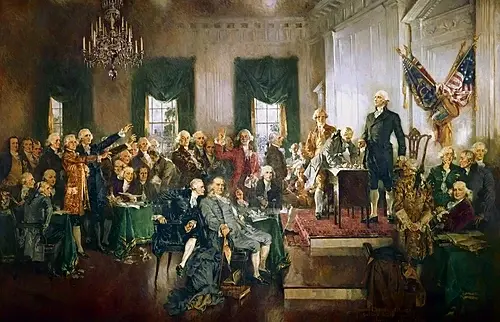Quiet Expansion: How a Vague Constitution Inspired the United States Government, Part I
- Sam Hamilton
- Jul 26
- 6 min read
Updated: Jul 31

Introduction:
The Founding Fathers were “first and foremost superb democratic politicians,” (Roche) and in the words of Noam Chomsky, “language is a weapon of politicians.” The importance of characterizing the Founding Fathers as “Democratic politicians,” and politicians themselves as masters of language, is to suggest that the Founding Fathers deliberately used obscure terminology to form a functioning federal government with an immense capacity for adaptability; it is not by accident that the U.S. government grew strong, rather, providing future American politicians the right to linguistic interpretation of the Constitution’s endowed powers was the Founding Fathers’ weapon and they wielded it shrewdly. In the following essay, I argue that by casting the federal government in a vague scaffolding of sweeping clauses without rigid boundaries of power, the Founding Fathers anticipated the development of a strong state in which the zeal of the citizenry would serve as the only true check on growth.
At its core, the Constitution empowers an expansive federal government not by the commission of despotic principles, but by the omission of clearly defined boundaries for this power. By excluding an exhaustive list of detailed restrictions, the Founding Fathers have allowed the government to figure out the particulars of its own institutions, from composition to operation. These particulars, however, often exhibit a compounding nature with the capacity to weigh quite heavily on society’s least powerful groups. To demonstrate, this article employs a series of case studies; from frontier administration to early American military and fiscal policy, the Spoils System, the Civil War, and eventually the bureaucracy, the American government progressed via inconspicuous usurpations of power. To reach this conclusion, I begin with an analysis of the Founders’ intentions: strength and invisibility. I then move forward in history, tracking key American developments through this lens.
In each section, interpretation of governmental authority by the government itself eventually leads to new power structures. Essentially, the Constitution creates an intentionally amorphous system, the government uses this system to expand its powers, and then the government creates a wide-ranging federal bureaucracy to administer these powers. If not for such a vague Constitution, American political development would certainly appear different today and likely (in a paradoxical manner) much less democratic.
Part I: Creating A Constitutional Framework for Growth
Section 1.1: The Framers’ Intent
The Articles of Confederation failed to unite the states in an effective manner; it afforded too little power to the federal government in the realms of fiscal and military policy. Recognizing the need for a new state structure, the pro-convention Constitutionalists drew their opponents into a “political trap: [state’s rights advocates] were not being asked to approve any specific program of reform, but only to endorse a meeting” (Roche). Constitutionalists recognized the discussion of reform as a necessary prerequisite to the formation of a stronger federal government and disguised their ambitions in vagueness accordingly.
The Federalists’ (many were Constitutionalists) goal for the convention was “to establish a much stronger central government… by democratic techniques of coercion” that would force the states to “emasculate themselves" (Roche). James Madison consolidated the Federalists’ power at the convention by proposing the Virginia Plan. The plan proffered a unitary national government with a democratically elected lower house responsible for the selection of upper house representatives; this legislative body would choose the executive together. As any competent businessman might, Madison anchored the Convention’s negotiations in rather extreme Federalist ideas, which likely influenced state rights concessions (Orr and Guthrie). In this way, the Constitutional Convention began with the Federalists in power due to clever interlocutory tactics (i.e., anchoring and the weaponization of small, unimposing agreements which might lead to larger concessions) and the negotiations to follow were biased in favor of a strong national government as a result.

The New Jersey Plan, a conglomerate of suggestions from the small states as a counter to the Virginia Plan, “would both retain strong national power and have a chance of adoption in the states" (Roche). Even the Federalists’ most ardent opponents recognized the need for strong national power, albeit presented modestly. The idea of presenting federal power modestly is important; by framing expansions in federal power as greatly limited and almost ineffectual in nature, those who opposed these expansions might view what is ostensibly a loss as a resounding victory. Recall, the Anti-Federalist states needed to ratify the Constitution without causing too much of a stir in their own states, which resulted in framing that painted substantive losses in the hue of resounding victory, essentially hiding the government’s new power from those who opposed it in order to soften the blow. Scholar Max Edling notes, “The Federalists believed that the federal government could only be successful if it avoided making heavy demands on the citizens and visible intrusions in their lives.”
The Connecticut Compromise eventually synthesized important elements from each plan, and the delegates convinced enough states to ratify. The new Constitution contained a series of clauses with ample room for interpretation. For example, the “necessary and proper” clause of Article I grants Congress the capacity “to make all Laws which shall be necessary and proper for carrying into Execution the foregoing Powers” (U.S. Const. Art. 1 Sect. 8, Clause 18). Similarly, Article II describes the President’s powers, vesting him with the duty to “take care that the laws be faithfully executed” (U.S. Const. Art. 2 Sect. 3). Perhaps most importantly, Article VI subordinates the states to the federal government. These three clauses are undoubtedly grants of immense powers that point to the Founders’ anticipation of a strong central government. The Founding Fathers recognized that crass grants of plenary powers would upset a public recently freed from despotic rule. Hence, invisibility was a bedfellow to state expansion from the beginning.
Section 1.2: The Invisible Hand of the U.S. Government Today
Before moving into historical examples, it might be helpful to consider this article’s argument from a modern perspective. The Constitution grants overarching, vague powers to the government, yet the average American regards government institutions as scant and ineffectual in their daily lives, perhaps even lacking in scope and force. This is one of America’s great ironies. Scholar Brian Balogh reconciles this inconsistency: “The federal government [rules] most effectively precisely when it is least visible.” As demonstrated in the following sections, the state’s power is most intense where it exercises maneuverability and invisibility (the frontier, early military and fiscal policy, the Civil War, and bureaucratic development). A modern example of invisible government power is the Supreme Court’s shadow docket, which the court uses to make influential decisions without hearing oral arguments and sometimes without even issuing opinions. The American state is quiet so as not to excite the general public, but its power is not lacking, especially for those on the peripheries.
Why is all of this important? In a country with a constitution as effective, but also as broad, as that of the United States, perhaps the only check on government power is the people. However, “submerging the state does not foster citizenship: it inculcates passivity and resentment” (Mettler). Hence, the only way to stifle boundless government expansion is by actively drawing attention to it. The common thread in each example this paper provides is that the public remained relatively uninvolved in the decision-making process. In this way, the state expanded with neither the consent nor the dissent of The People, which is not (in a constitutional sense) the fault of the government. The government is empowered to believe its expansions are acceptable if not vetoed by the citizens.
To sum up my argument in Part I, the Federalists recognized the need for more power exercised in a concealed manner in the ratification fight. This recognition ultimately led to the Connecticut Compromise, and therefore, the Constitution with all its murky clauses. Thus, the United States government operates in a framework that: (1) Allows it to grow strong via internal interpretations of its constitutional powers, and (2) Allows it to exert power quietly unless called out by Americans. With this framework in mind, I turn to early political developments in Part II.
Sources
Balogh, Brian. A Government out of Sight: The Mystery of National Authority in Nineteenth-Century America. Cambridge: Cambridge University Press, 2009.
Edling, Max M. A Revolution in Favor of Government: Origins of the U.S. Constitution and the Making of the American State. New York: Oxford University Press, 2003.
Mettler, Suzanne. The Submerged State. London: University of Chicago Press, 2011.
Orr, Dan, and Chris Guthrie. "Anchoring, Information, Expertise, and Negotiation: New Insights from Meta-Analysis." Ohio State Journal on Dispute Resolution 21, no. 3 (2006): 597-628.
Roche, John P. "The Founding Fathers: A Reform Caucus in Action." The American Political Science Review 55, no. 4 (1961): 799-816.
Totenberg, Nina. "The Supreme Court and 'The Shadow Docket.'" National Public Radio. Last modified May 22, 2023, https://www.npr.org/2023/05/22/1177228505/supreme-court-shadow-docket.














Comments